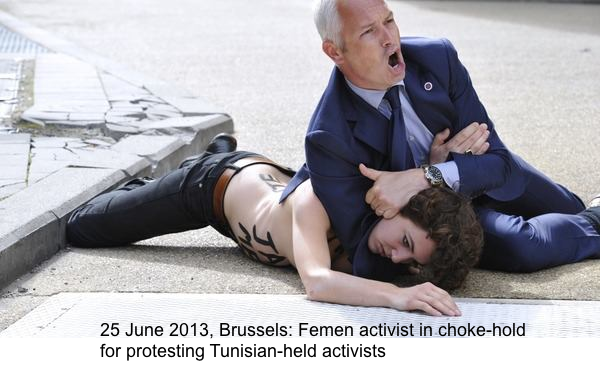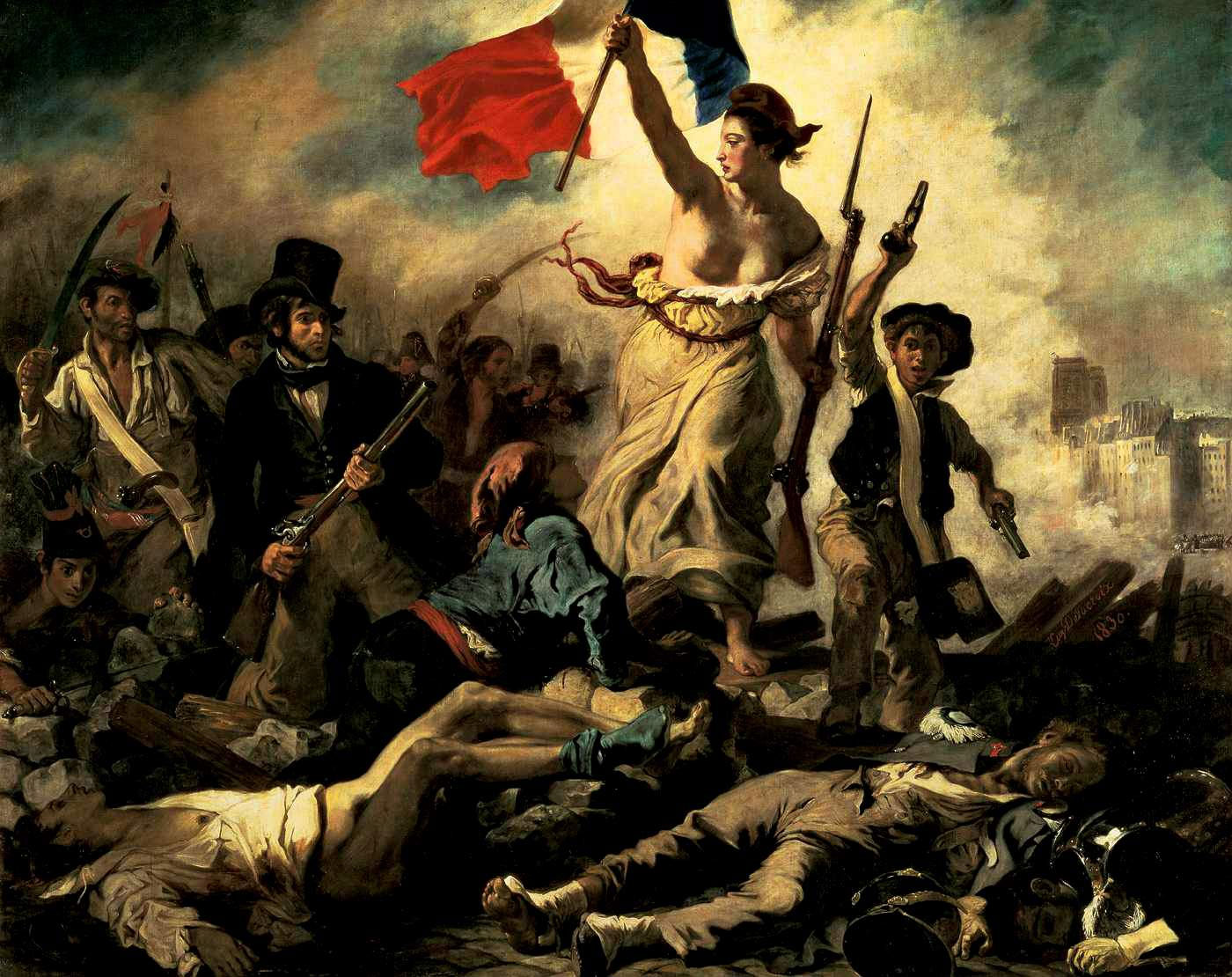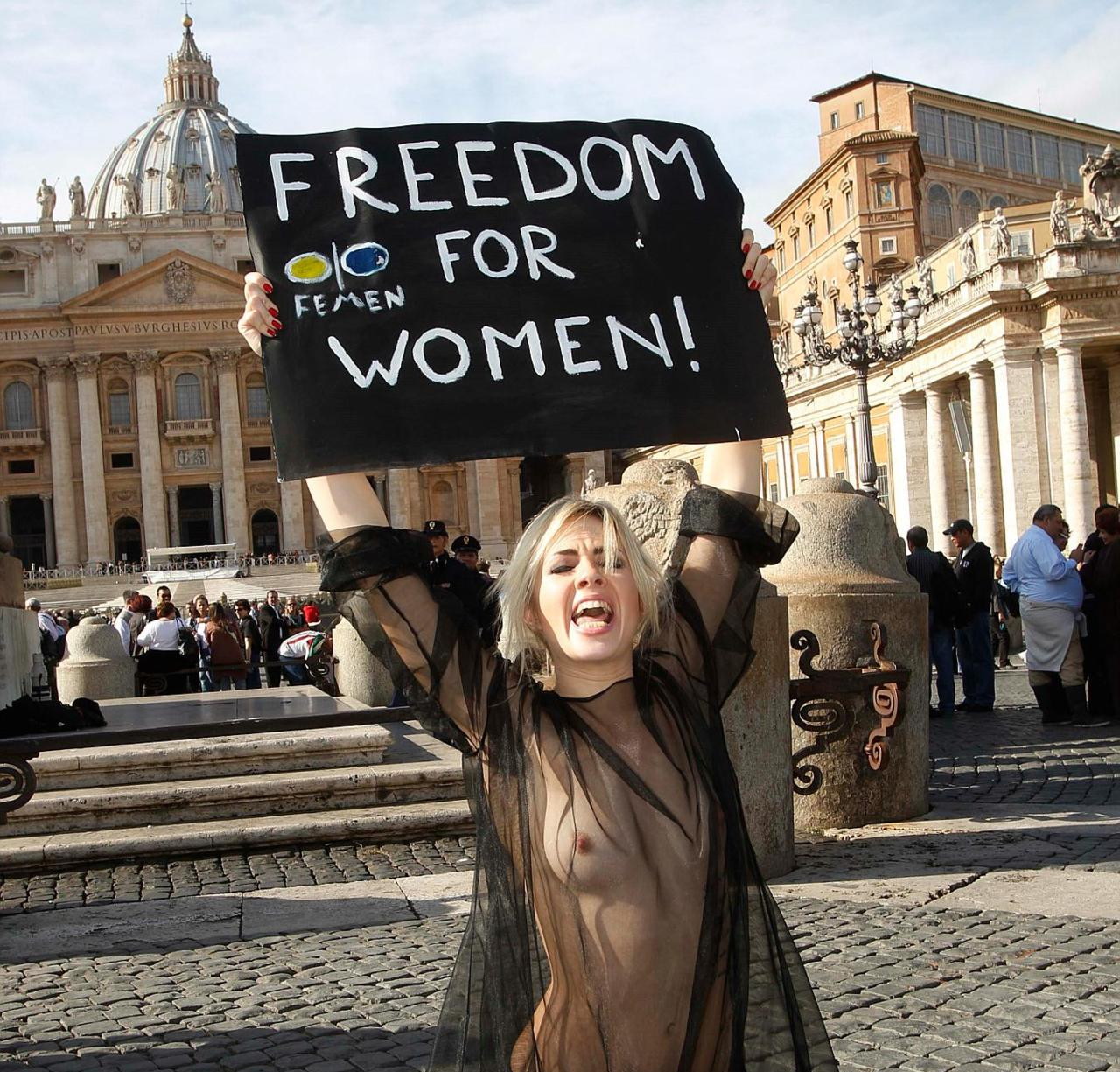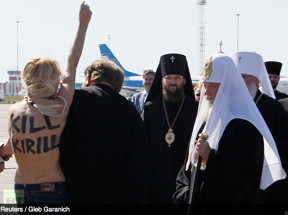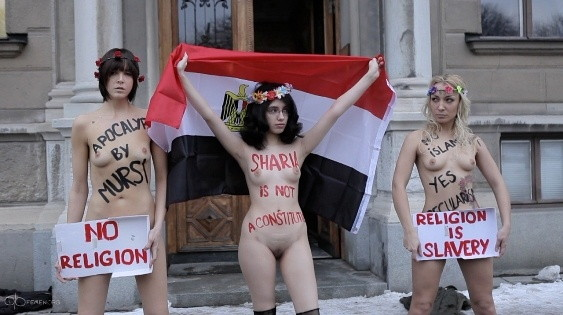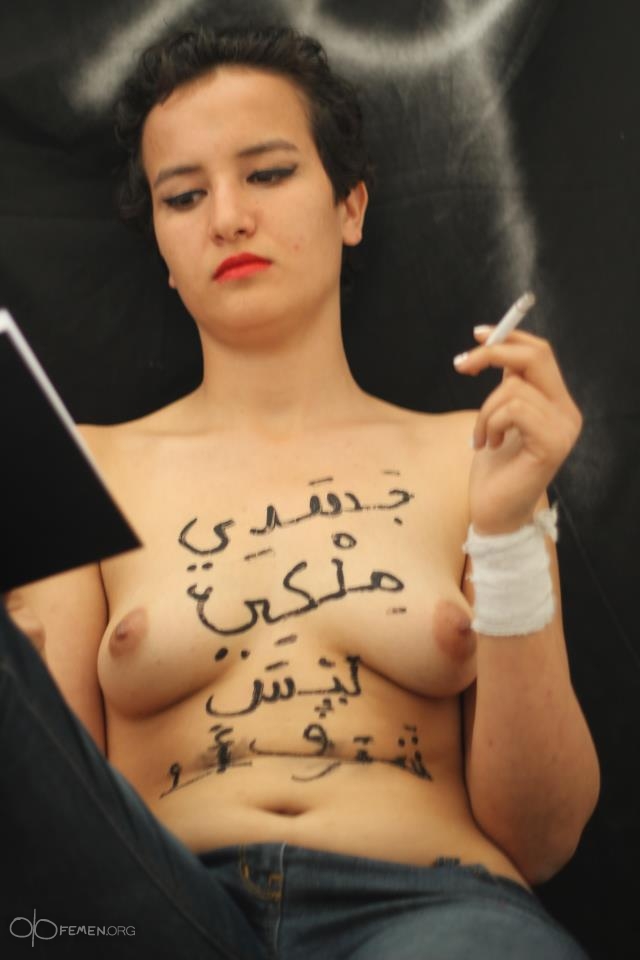August 17: Femen Cuts the Cross in Kiev (2012)
Femen's Topless Protests Against the Patriarchy
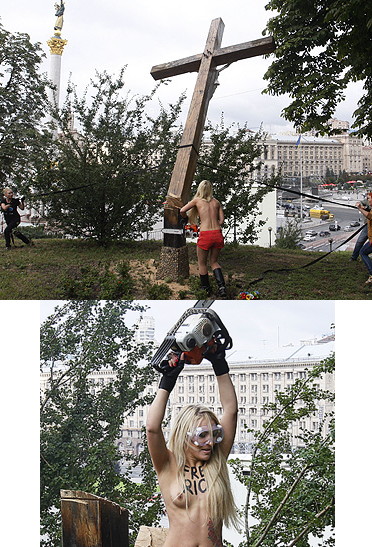 It was on this date, August 17, 2012, that a half-naked, 22-year-old Ukrainian woman cut down a four-meter (13-foot) wooden cross overlooking Independence Square (Майдан Незалежності) in the Ukrainian capital, Kiev. Inna Shevchenko, wearing only red shorts and wielding a chainsaw, was assisted by two other members of Femen, a Ukrainian feminist protest group based in Kiev. The protest this time was in support of the feminist punk band Pussy Riot, three members of whom (Nadezhda Tolokonnikova, Maria Alyokhina and Yekaterina Samutsevich*) were to be sentenced later that day for “hooliganism motivated by religious hatred.”
It was on this date, August 17, 2012, that a half-naked, 22-year-old Ukrainian woman cut down a four-meter (13-foot) wooden cross overlooking Independence Square (Майдан Незалежності) in the Ukrainian capital, Kiev. Inna Shevchenko, wearing only red shorts and wielding a chainsaw, was assisted by two other members of Femen, a Ukrainian feminist protest group based in Kiev. The protest this time was in support of the feminist punk band Pussy Riot, three members of whom (Nadezhda Tolokonnikova, Maria Alyokhina and Yekaterina Samutsevich*) were to be sentenced later that day for “hooliganism motivated by religious hatred.”
Pussy Riot’s crime, according to authorities, was protesting – via a performance, on 21 February 2012, on the soleas of Moscow’s Cathedral of Christ the Savior – the Russian Orthodox Church leader’s support for Vladimir Putin during Putin's election campaign. The performance was later that day turned into a music video entitled “Punk Prayer – Mother of God, Chase Putin Away!” Following the “Punk Prayer” incident, the Russian Orthodox Church called on the government to criminalize blasphemy. The actions of Femen in support of Pussy Riot drew mixed reactions for the cutting of the cross, erected in 2005 in memory of the victims of repression under Soviet dictator Josef Stalin. It brought another charge of “hooliganism” and even a rebuke from Pussy Riot – a Pussy Riot spokesperson thanked Femen but disavowed their actions. Inna Shevchenko fled Ukraine to set up a Femen affiliate in France.
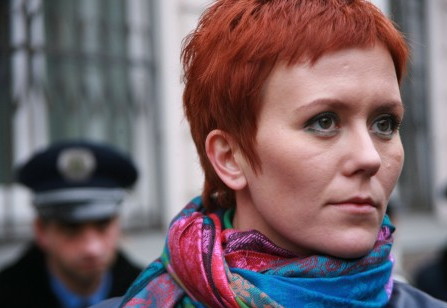 The Femen movement was founded on 10 April 2008 by Anna Hutsol after she became aware of sad stories of Ukrainian women duped into going abroad, only to be sexually exploited. An economist by training, Hutsol recruited women to protest the sex tourism that had become common in Ukraine. In a 2011 interview, the then-26-year-old leader, explained: “Our goal is active Ukrainian women who want to be involved in society and politics. … We thought we'd create an organization where young girls could come and help others like them and help society. And the format we picked was this extremely sexy, bright way of presenting ourselves.” Femen’s trademark topless protests, always in public in front of cameras, wearing nothing above the waist but a flower wreath in their hair, did not start until 2010. Explained its website (in English), “This is the only way to be heard in this country. If we staged simple protests with banners, then our claims would not have been noticed.”
The Femen movement was founded on 10 April 2008 by Anna Hutsol after she became aware of sad stories of Ukrainian women duped into going abroad, only to be sexually exploited. An economist by training, Hutsol recruited women to protest the sex tourism that had become common in Ukraine. In a 2011 interview, the then-26-year-old leader, explained: “Our goal is active Ukrainian women who want to be involved in society and politics. … We thought we'd create an organization where young girls could come and help others like them and help society. And the format we picked was this extremely sexy, bright way of presenting ourselves.” Femen’s trademark topless protests, always in public in front of cameras, wearing nothing above the waist but a flower wreath in their hair, did not start until 2010. Explained its website (in English), “This is the only way to be heard in this country. If we staged simple protests with banners, then our claims would not have been noticed.”
Femen's message is almost invariably in English. Femen activists invariably shout in English. Even the name of the group is written "FEMEN" in every language, even Russian (only occasionally is it printed in Ukrainian as Фемен).
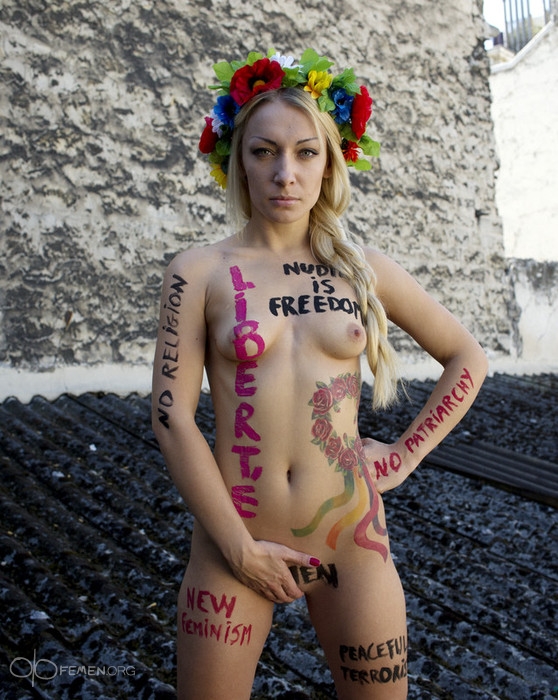 Femen’s feminist agenda broadened under the leadership of Hutsol in Ukraine, under Inna Shevchenko in Paris (est. 9/18/12) and in Berlin (est. 1/24/13) under Alexandra Shevchenko. Using “sextremism” to protect women’s rights, promote democracy and attack the patriarchy “in all its forms: the dictatorship, the church, the sex industry,” the Femen slogan is, “Our God is woman, our mission is protest, our weapons are bare breasts!”
Femen’s feminist agenda broadened under the leadership of Hutsol in Ukraine, under Inna Shevchenko in Paris (est. 9/18/12) and in Berlin (est. 1/24/13) under Alexandra Shevchenko. Using “sextremism” to protect women’s rights, promote democracy and attack the patriarchy “in all its forms: the dictatorship, the church, the sex industry,” the Femen slogan is, “Our God is woman, our mission is protest, our weapons are bare breasts!”
Affirming its anti-religious stand, in an 22 April 2013 interview, Inna Shevchenko of Femen France (pictured left) explained, “… We divide the patriarchy confronting us into three basic parts. First, dictatorship, as a tool for enslaving women. For this reason we are a democratic movement. The second part of the system consists of religion and the church, which have overseen the spiritual enslavement of women. For this reason Femen is an atheistic group motivated by secularism and humanism. The third element of the patriarchy is the sex industry, which has been responsible for women’s sexual servitude and is in fact the most ancient form of female slavery. For this reason, then, Femen sees sexuality as the organon [instrument or tool] and canon of women’s freedom. Hence, our three basic postulates are democracy, atheism, and sexuality. …”
Naked protest has a long history, but not one traditionally tied to feminism. There were the Adamites for North Africa, dating from about 100 CE, whose practice of “holy nudism” was attested by none other than Augustine of Hippo. There is the legendary Lady Godiva, an 11th-century Anglo-Saxon noblewoman, the wife of Leofric, Earl of Mercia, who rode naked through Coventry to protest oppressive taxes – an odd form of protest because people were not allowed to watch and “Peeping Tom” was punished for doing so! The first recorded naked mass protest took place in Canada in 1903, when a religious sect called the Doukhobors made bonfires of their weapons to protest conscription in the Czar’s army and graduated from pyromania to nudity, seeking to “walk with the simplicity and moral purity of Christ.”
In more recent times, there have been naked protests in Nigeria, Liberia, Kenya and Uganda for most of a century, dating to the Women’s War in Eastern Nigeria (1929), as a manifestation of black women’s resistance to colonial authority and racialised Western notions of the body. When the South African National Council of Provinces proposed a ban on “virginity testing” in 2005, bare-breasted Zulu virgins and their supporters danced and sang their way through the streets of Pietermaritzburg, in protest. Animal rights groups such as People for the Ethical Treatment of Animals (PETA), have used (mostly implied) nudity to draw attention to their causes. “Breasts Not Bombs” is an anti-war political movement based in Mendocino County, California, which focuses on the intersection between top-free equality and social justice through non-violent public protests. “Baring Witness” describes itself as “a global partnership of men and women who create words of peace with their bodies.” The World Naked Bike Ride (WNBR) is an international clothing-optional bike ride in which participants “protest oil dependency and celebrate the power and individuality of our bodies.”
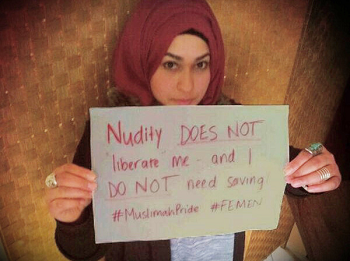 Femen Swims Against the Main Stream
Femen Swims Against the Main Stream
The caricature fed to us by the media as “mainstream feminism” is in fact ideological or academic feminism, which is to real feminism what caviar is to frozen fish sticks: there is a place for it, but not among workaday women. Real feminism is not elitist, or exclusively white and middle class. Real feminism is a woman of any color or class going to work every day and being treated like a colleague. Imagine that!
Still, Femen’s feminism, while running counter to academic feminism, has yet to be embraced by the proletariat. Neither is it highly regarded in the Muslim world, where the Muslimah (Muslim women) – either because they fear worse repression for supporting Femen or because they truly believe their second-class legal and social status is something of which to be proud – criticize Femen for being white, elitist and imperialist – as if freedom and self-determination are Western-only values. Pushing back against this critique, here is how Femen justified its methods after protesting topless in a Swedish mosque—
Human rights are priorities that come before culture or religion. … We find it very disproportionate to speak about disrespect against a sacred space as something worse than the disrespect towards living beings: children, women, homosexuals, etc. The way women are being treated in the name of Islam, in their homes, in the streets and in prisons, should make a lot more headlines in media than our bare breasts in a mosque! … Femen is against theocracies and we use our breasts as a political tool to make our message heard. (Facebook posting by Femen Sweden, 29 April 2013)
When you consider it, feminism has always had to push back against religion. But because elitist academic feminism has gone so mainstream, it has become less respectable to criticize anti-feminism at its source. The subjugation of women is not just a policy of the patriarchy, but its raison d’être. Religion is not just the chief support of patriarchal predominance over feminine freedom – it is the patriarchy’s modus operandi. Men wield the hand of God to oppress women through self-serving deference to divine dictates as men interpret them. In a 2013 profile in the Independent, Femen founder Anna Hutsol says, “Feminists can’t be religious … There is no such thing as Orthodox or Catholic feminists or, most absurdly of all, Islamic feminists. It’s ridiculous. They are antagonistic ideologies; mutually exclusive.” Hutsol continued, saying that, given the historical abuses against women carried out in the name of religion, “all women are obliged to demand the destruction” of all religions.
On a TV interview program called “iTalk” (EuroNews, 6/25/13) Femen France founder Inna Shevchenko was asked by a young British man why feminism and religious tradition can’t work together; the moderator added, “Are you against all religion?” Shevchenko replied, “Yes. Where religion is starting, feminism is finishing. We are definitely [an] atheistic movement. We are [an] anti-religious movement. But I don’t want anyone to mix this sentence with that we are against faith. I don’t care how many times people pray during the day, but I care when they say what I have to do with my life.”
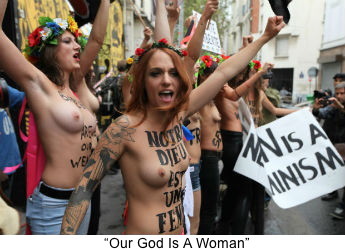 But can’t women protest without getting undressed? Why protest naked? Why play into male sexual fantasies? Academic feminists and anti-feminists have more in common than they might candidly acknowledge. Anti-feminists assume that a woman, without a man telling her to, cannot possibly enjoy sex, cannot possibly enjoy being naked, cannot possibly enjoy dressing in a way that is pleasing to herself. But the academic feminist counter-argument is the worst form of feminism: it allows an authoritarian woman to replace an authoritarian man, that is, a woman, without another woman telling her to, cannot enjoy sex, cannot enjoy being naked, cannot enjoy dressing to please herself. The answer to both should be: Doesn’t the very soul of freedom reside in each individual woman deciding for herself how to think, to feel and to act?
But can’t women protest without getting undressed? Why protest naked? Why play into male sexual fantasies? Academic feminists and anti-feminists have more in common than they might candidly acknowledge. Anti-feminists assume that a woman, without a man telling her to, cannot possibly enjoy sex, cannot possibly enjoy being naked, cannot possibly enjoy dressing in a way that is pleasing to herself. But the academic feminist counter-argument is the worst form of feminism: it allows an authoritarian woman to replace an authoritarian man, that is, a woman, without another woman telling her to, cannot enjoy sex, cannot enjoy being naked, cannot enjoy dressing to please herself. The answer to both should be: Doesn’t the very soul of freedom reside in each individual woman deciding for herself how to think, to feel and to act?
There is something media-savvy about attractive women going half-naked and shouting to be heard on issues that affect them: it is still shocking in Western culture; it is revolutionary in Middle-Eastern culture. Messages painted on bare torsos get more attention than when painted on flat posters. Breasts look better with arms raised. But pictures of women engaged in Femen protests routinely have their nipples erased, on Facebook and in the mainstream media, as if there is nothing so threatening to patriarchy as a bare-breasted woman with arms raised and protest slogans painted on her body. But the most important Femen protest of all is against the oppression of women based on religious doctrine. Indeed, if you watch their protests carefully, you will see that Femen is “in-your-face” protest, but that Femen does not engage in violence: violence is frequently committed against the women activists, as it is committed against women generally by the patriarchy, as it is endorsed by religion in society generally.
And there are at least five perfectly sound reasons to protest undressed, according to writer Nadine Bloch: (1) Nakedness has its own media shock value; (2) Nudity embodies vulnerability; (3) Being naked emphasizes our connection to nature (e.g. PETA); (4) Show you have skin in the game; (5) When you’ve got nothing left to wear… wear nothing! Furthermore, as one blogger put it, “the coverage of naked protest in the media far outweighs that of any other protest form and it’s hard to argue with success” … “The very idea of nakedness in public has a mocking edge, because suddenly everyone else looks ridiculously overdressed. It speaks truth to power in the most elemental sense and is safer for the participants because naked people are defenceless, they pose no threat and can’t reach for a weapon from pockets they don’t have.”
Controversial and confrontational in tactics, the topless feminism of Femen is neither unprecedented nor even ahistorical. In fact, Femen is justified in calling themselves a topless revolution: who can forget the signature 1830 painting by Eugène Delacroix from the French Revolution, a barefoot, bare-breasted woman leading the people forward over the bodies of the fallen: Liberty Leading the People?

